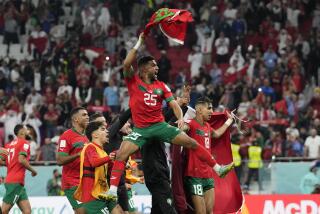Commentary : Regions’ Distinctive Soccer Styles Lost in Rush for World Cup
- Share via
ROME — Soccer’s global village has put its stamp on the World Cup, leveling the difference in quality that used to relegate small soccer nations to lovable losers.
Now, a Soviet coach is leading Cameroon to glory. A Yugoslav coach does likewise with Costa Rica. A Brazilian has taken the United Arab Emirates to the World Cup, and South Korea tried to lure a Belgian to lead them in Italy.
The mix does not always produce the most exciting soccer, and many distinctive styles are blending with one another. Brazil is trying to combine Latin flair with European realistic defense--using a sweeper for the first time--and few people are cheering.
Sometimes, it is forced upon a team by desperation. England abandoned the essence of its game--conservatism--and opted for a European sweeper-style defense to revive its flagging fortunes.
Most of the time, soccer’s globalism is driven by money. Italy’s major league has become the melting pot of the game’s superstars, blending the different styles into a whole that often is better than the sum of its parts.
And it makes its practitioners--players such as Argentina’s Diego Maradona, Brazil’s Careca and Marco van Basten of the Netherlands--into millionaires.
Unheralded African players had to take a different approach. They landed in Europe mainly because they were a lot cheaper than the top local players. And often they tried harder and performed better. They honed their skills on a highly competitive level, and slowly the African nations are catching up. Many European coaches have left for Africa to put the finishing touches on that progress.
But even if Cameroon stunned the world with its two wins over defending world champion Argentina and Romania, critics say something got lost along the way.
“African soccer increasingly looks less African and no longer represents our basic qualities,” Cameroon goalie Joseph-Antoine Bell said. “(European) coaches leave for Africa with all kinds of theories, but they know nothing of the African mentality.”
But who can now doubt the tactics of Cameroon’s Soviet coach, Valery Nepomnyashchy? He has curbed the free-flowing but often inefficient African style with stringent European realism.
Cameroon played ugly on defense and cut down Argentine strikers to slash its way to a 1-0 victory in the World Cup opener, perhaps the greatest upset in the tournament’s history.
As late as the 1970s, Africa played with more reckless abandon, and Zaire lost 9-0 to Yugoslavia in the 1974 World Cup.
Now an African nation is in the second round for the second time running. Morocco won its first-round group in Mexico in 1986.
Blending systems is also criticized in Brazil, where Sebastiao Lazaroni wants to curb the trademark sparkling offense with stubborn European defense.
Reducing Brazil’s striking force from three to two was seen as blasphemy at home, and all-time great Pele blasted Lazaroni for his tactics.
But even if the crowds are less awed, Lazaroni has won Brazil’s first major title in 19 years by capturing last year’s South American championship.
Costa Rica has become a player at the World Cup after Yugoslav Coach Bora Milutinovic taught it stringent and often boring defense.
“Costa Rica never really attacked. They simply defended,” Lazaroni said after Brazil’s 1-0 win.
South Korea wanted to hire Belgian veteran Coach Guy Thys for the World Cup, but Thys thought it a bit too exotic. He rejoined the Belgian team and already is in the second round.
Sometimes, it pays to stay home.
More to Read
Go beyond the scoreboard
Get the latest on L.A.'s teams in the daily Sports Report newsletter.
You may occasionally receive promotional content from the Los Angeles Times.







